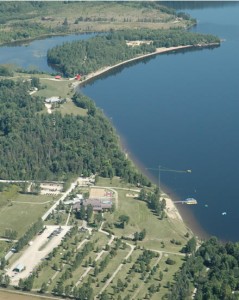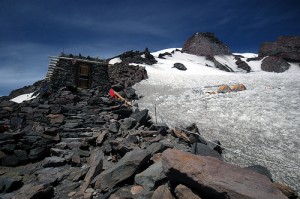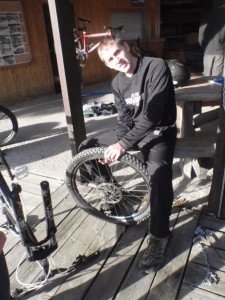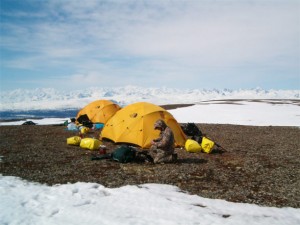This two-day Search and Rescue course offered an introduction to Search and Rescue procedures and situations. This was an introduction and insight into search and rescue programs (without certification) geared to orient and give us some tools so we, as guides, can assist full search and rescue teams should the need come up. Who knows the forest better than those who guide it (us) so basic knowledge will allow us to partner with and assist authorities.
 The first day we spent learning techniques (Probability of Areas, hasty searches), history and case studies, as well as different types of terrain-searches (water, snow, forest). At the end of the first day we were told that the next day we would have a field exercise to find four people “lost” in the forest around our training facility, Wilderness Tours (WT). We had about an hour and a half to do some preplanning for the next day.
The first day we spent learning techniques (Probability of Areas, hasty searches), history and case studies, as well as different types of terrain-searches (water, snow, forest). At the end of the first day we were told that the next day we would have a field exercise to find four people “lost” in the forest around our training facility, Wilderness Tours (WT). We had about an hour and a half to do some preplanning for the next day.
The next day we left Pembroke at noon to travel to WT. We had about two and a half hours before we got the “call” saying there were four hikers lost in the forests close by. Our two leaders were pre-picked and we split into groups of four or five, separated and combed assigned areas in search of missing hikers.
My group was poorly organized. We knew where we were going and what we were supposed to do but getting there was a completely different story. We were lost for about an hour, then realized we were way off track. Once we re-oriented our position, base-camp notified us that three people had been found and they knew where the fourth one was so we just headed back to camp. Learning from mis-steps taught us new understanding of the dangers and challenges to a full-on search and rescue mission where lives can be at stake.
In the end it only took fifty of us four hours to find four people. Strategy, planning, knowing the terrain and field searching introduced us to a better understanding of search and rescue. I thought it was kind of fun, the adrenaline of being part of a field search for a missing person. I would definitely do it again given the opportunity – hopefully real opportunities are few and far between!
Tags: Algonquin College, compass, Ottawa River, Ottawa Valley, Outdoor Adventure Program, Pembroke, rescue, Search, Search and Rescue, survival, Wilderness, Wilderness Tours
Where to Find them?
Finding the gear you want may not always be the easiest task on your list (we found this out trying to find a winter tent in January). After you’ve researched the brands and found the features you desire, now try to find the gear. Online, you can find almost anything from any brand, but often you want to touch and feel to make sure your decision is right. Here is a list of gear shops we found that were well-stocked and ready for business. We’ve even added our AdventureFrik recommendations!
Eastern and Northern Ontario Gear Shops
(excluding Toronto, bounded Hwy. 400 and East, alphabetical by city)
Algonquin Outfitters **Adventurefrik recommended**
RR 1. Oxtongue Lake
Dwight, ON, (705) 635-2243
Trailhead
272 Princess St, Kingston, (613) 546-4757
1960 Scott St, Ottawa, (613) 722-4229
Bigwood Sporting Goods
139 Worthington Street
North Bay, ON, (705) 474-7425
Lefebvre’s Outdoor Sports
122 Main St West
North Bay, ON, (705) 474-5920
Bushtukah **Adventurefrik recommended**
203 Richmond Road
Ottawa, ON, 1-888-993-9947
The Expedition Shoppe
43 York Street, (613) 241-8397
369 Richmond Rd, (613) 722-0166
Ottawa, ON
GearHeads **Adventurefrik recommended**
3025 Petawawa Blvd
Petawawa, ON, (613) 687-4624
Wild Rock Outfitters
169 Charlotte Street
Peterborough, ON, (705) 745-9133
Ramakko’s
125 Loach’s Road
Sudbury, ON, (705) 522-8889
The Outside Store
2041 Long Lake Road
Sudbury, ON, (705) 522-1755
Gear Up For Outdoors
894 Alloy Place
Thunder Bay, ON, (807) 345-0001
Wilderness Supply
244 Pearl St.
Thunder Bay, ON, (807) 684-9555
Happy Shopping and let me know any favorites you have to add to the list!!
Tags: canoeing, gear, Gear Shops, Level Six, Marmot, Mountain Equipment Co-op, Mountain Hardwear, North Face, outdoor gear, Sierra Designs, tents
Where to Find them?
Finding the gear you want may not always be the easiest task on your list (we found this out trying to find a winter tent in January). After you’ve researched the brands and found the features you desire, now try to find the gear. Online, you can find almost anything from any brand, but often you want to touch and feel to make sure your decision is right. Here is a list of gear shops we found that were well-stocked and ready for business. We’ve even added our AdventureFrik recommendations!

Southern Ontario
(excluding Toronto, bounded Hwy. 400 and West, alphabetical by city)
Sojourn
31 Commerce Park Drive
Barrie, ON, (705) 739-9694
Mountain Equipment Co-op (MEC) **AdventureFrik recommended**
1030 Brant St.
Burlington, ON, (905) 333-8559
Sojourn
510 First Street
Collingwood, ON, (705) 446-1990
Sporting Life
222 Hurontario St.
Collingwood, ON, (705) 445-3773
Squire John’s Ski Shop
RR #3,Highway 26 West,
Collingwood, ON, (705) 445-1130
Suntrail Outfitters
100 Spencer St, Hwy #6
Hepworth, ON, (519) 935-2478
Algonquin Outfitters **AdventureFrik recommended**
86 Main Street East
Huntsville, ON, (705) 787-0262
Webco Sports **AdventureFrik recommended**
240 Duke Street West
Kitchener, ON, (519) 744-1321
Novack’s
211 King Street
London,ON, ON, (519) 434-2282
Europe Bound (Hikers Haven) **AdventureFrik recommended**
166 South Service Rd. East
Oakville, ON, (905) 849-8928
White Squall Ventures
19 James Street
Parry Sound, ON, (705) 746-4936
Outdoors Oriented
111 Fourth Avenue
St. Catharines, ON, (905) 688-0160
Adventure Guide **AdventureFrik recommended**
382 King Street North
Waterloo, ON, (519) 886-3121
Coast Mountain Sports
Barrie. Hwy 26 & 27, (705) 722-1060
Markham, 5000 Hwy 7 E., (905) 948-8020
Mississauga, 199 Rathburn Rd, (905) 281-8422
Mississauga, 5100 Erin Mills Parkway, (905) 828-8341
Oakville, 2460 Winston Churchill Blvd.. (905)829-4721
Happy Shopping and let me know any favorites you have to add to the list!!
Tags: gear, Gear Shops, Marmot, Mountain Equipment Co-op, Mountain Hardwear, North Face, outdoor gear, Sierra Designs, tents
When part of your Outdoor Adventure college course says you have to do cross-country cycling next week, what do you think of? I think of something like the Tour de France. I was proven seriously wrong a few weeks ago when I had this very course. Sure, we got there and had to sit for an hour learning parts and different types of bikes, but once we got outside and sized up our bikes we had a killer time.
 First we had to size up the bike. To tell if your bike is the right size for you, mount the bike and stand over the cross-bar of your bike facing forward with your butt right in front of the seat. With your legs straight, put your hand in a fist and stick it under your groin between the bar and your body. If the bike is the right height, your fist should have slight clearance (5 mm) on each side. To test your seat height, place one foot on the pedal in the lower position. The seat is set correct if you only have a slight bend in your knee. Test the brakes and handle bars for smooth movement and make sure the tires are very firmly inflated. For safety gear, helmets are required, especially if you are heading off-road like we were.
First we had to size up the bike. To tell if your bike is the right size for you, mount the bike and stand over the cross-bar of your bike facing forward with your butt right in front of the seat. With your legs straight, put your hand in a fist and stick it under your groin between the bar and your body. If the bike is the right height, your fist should have slight clearance (5 mm) on each side. To test your seat height, place one foot on the pedal in the lower position. The seat is set correct if you only have a slight bend in your knee. Test the brakes and handle bars for smooth movement and make sure the tires are very firmly inflated. For safety gear, helmets are required, especially if you are heading off-road like we were.
 In our cross-country cycling course we learned everything from wheelies to endos (opposite of a wheelie) to hops to jumps. Man this class was the bomb! We were riding Norco Bigfoots mostly and these bikes can take a serious beating. In the afternoon we took these bikes apart and learned the basics of repair.
In our cross-country cycling course we learned everything from wheelies to endos (opposite of a wheelie) to hops to jumps. Man this class was the bomb! We were riding Norco Bigfoots mostly and these bikes can take a serious beating. In the afternoon we took these bikes apart and learned the basics of repair.
 The second day of this class we did a 40 km ride around our training facility, Wilderness Tours. We did half of this on the road and the other half on trails. If you ever have a chance to run single track biking, take it without a second thought. Single tracks are trails in the forest for bikes. They could have jumps, turns, hills, etc. and really test the mettle of the bike and the cyclist. What a blast!
The second day of this class we did a 40 km ride around our training facility, Wilderness Tours. We did half of this on the road and the other half on trails. If you ever have a chance to run single track biking, take it without a second thought. Single tracks are trails in the forest for bikes. They could have jumps, turns, hills, etc. and really test the mettle of the bike and the cyclist. What a blast!
So far biking is my favourite of the fall activities.
Tags: cross-country, cycling, endo, hops, Norco Bigfoot, Outdoor Adventure, wheelie, Wilderness Tours

 I had the privilege this week to go to Beachburg Forest. Here we began to understand how to navigate and orient ourselves wherever we were. Our instructors lined us up along the forest edge and told us to walk through and back and see if we came out where we had originally started. The instructors didn’t expect them to be logging in the forest but sent us through anyways confident that we would know when it wasn’t safe for us. The first half we were climbing over cut red pine trees and easy bush-wacking. Then we had to traverse where they had just started logging. It wasn’t too bad, the skidder was still far enough away that I could walk by and not worry about them. I arrived at the opposite destination and began to navigate back to the start. On the return route I encountered heavy logging activity very close to me. To work around the skidding, I decided to use a technique called pacing. This involves turning and walking directly to the left or right and counting your paces. Then walk forward until you are past the object, then count your paces back to the left or right. Believe it or not, at the original forest edge I ended up directly on my marker when I came out.
I had the privilege this week to go to Beachburg Forest. Here we began to understand how to navigate and orient ourselves wherever we were. Our instructors lined us up along the forest edge and told us to walk through and back and see if we came out where we had originally started. The instructors didn’t expect them to be logging in the forest but sent us through anyways confident that we would know when it wasn’t safe for us. The first half we were climbing over cut red pine trees and easy bush-wacking. Then we had to traverse where they had just started logging. It wasn’t too bad, the skidder was still far enough away that I could walk by and not worry about them. I arrived at the opposite destination and began to navigate back to the start. On the return route I encountered heavy logging activity very close to me. To work around the skidding, I decided to use a technique called pacing. This involves turning and walking directly to the left or right and counting your paces. Then walk forward until you are past the object, then count your paces back to the left or right. Believe it or not, at the original forest edge I ended up directly on my marker when I came out.
Comments